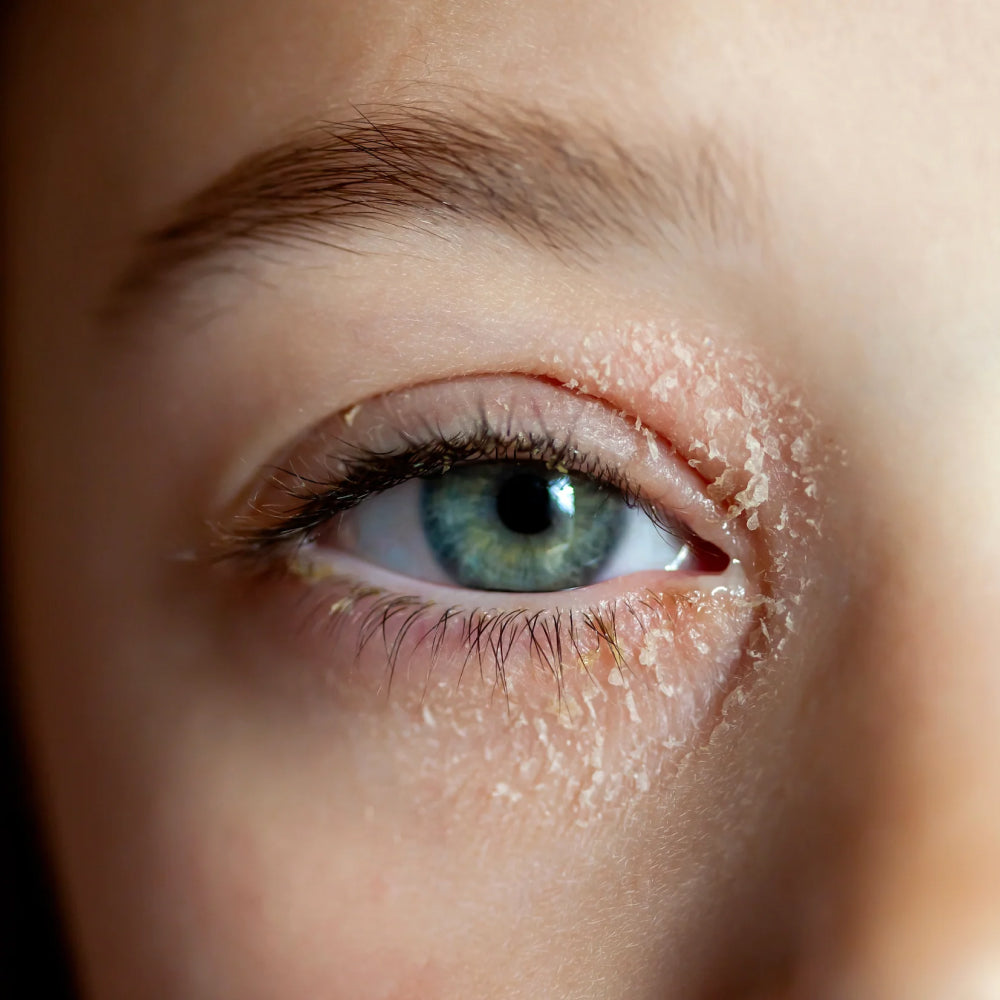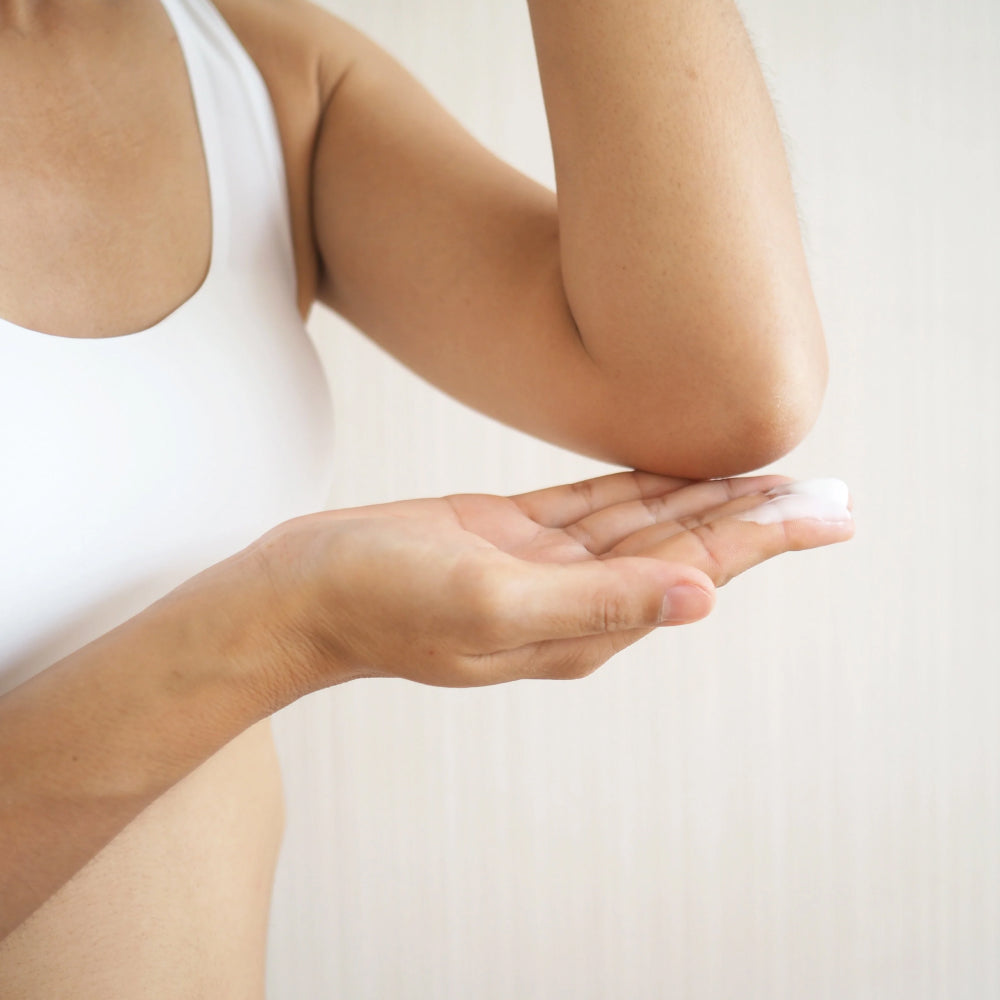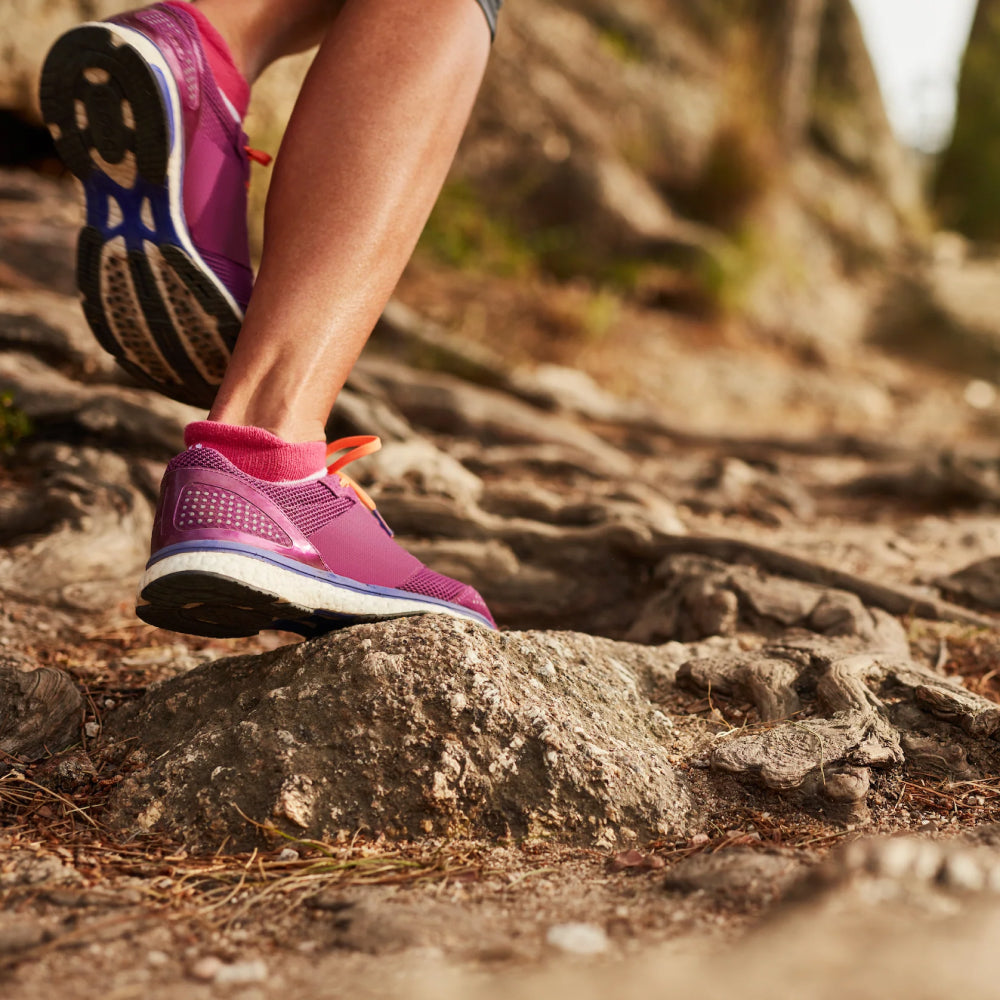Dealing with skin conditions like eczema or athlete’s foot can be frustrating, as the irritation often prevents you from enjoying your favorite activities. Although both conditions share symptoms like swelling, dryness, and itching, they are distinct disorders. Specifically, athlete’s foot is a contagious fungal infection that mainly affects the toes, while eczema is an inflammatory skin disorder often influenced by genetics and environmental factors.
In this article, you will learn the key differences between eczema vs athlete’s foot, including their causes, symptoms, and ways to avoid them.
What is Eczema?
Commonly mistaken for athlete's foot, eczema is a long-term, inflammatory skin disorder characterized by dry, itchy patches with common flare-ups that can temporarily worsen symptoms.
Atopic dermatitis is the most common form of eczema. According to the National Eczema Association, approximately 31 million Americans suffer from eczema, which can develop at any age.
What is Athlete's Foot?
A key distinction between athlete's foot and foot eczema is its fungal nature, which spreads from one person to another. Athlete’s foot symptoms can sometimes involve the soles and heels but often include redness, itching, and cracked or peeling skin (Cleveland Clinic, 2021, Athlete’s foot: What it looks like, symptoms & treatment).
Antifungal oral or topical treatments are required to relieve symptoms and promote skin healing effectively.
Eczema vs Athlete’s Foot: 4 Key Differences
To properly address various skin disorders, it matters to figure out how they differ. Here are four key differences to tell eczema vs athlete’s foot apart (Cleveland Clinic, 2021, Athlete’s foot: What it looks like, symptoms & treatment; Mayo Clinic, 2023, Atopic dermatitis (eczema) - symptoms and causes; National Eczema Association, 2017, What is eczema?).
|
Eczema |
Athlete’s Foot |
|
|
Causes |
Eczema is caused by genetics and immune factors in coordination with environmental irritants or allergens like chemicals, fragrances, certain food, or dyes (National Eczema Association, 2017, What is eczema?). |
Athlete’s foot is caused by dermatophyte fungi, commonly found in moist, warm environments like locker rooms, showers, or swimming pools. Unlike eczema, athlete’s foot is contagious and can spread easily through direct contact or shared spaces (Cleveland Clinic, 2021, Athlete’s foot: What it looks like, symptoms & treatment) |
|
Symptoms |
According to the National Eczema Association and Mayo Clinic, eczema symptoms vary between individuals. • Dryness • Rough, scaly, or tough patches • Sensitive or itchy skin • Inflamed, discolored skin areas • Oozing or crusting in severe cases |
Cleveland Clinic indicates athlete’s foot symptoms include: • Itchy, red, peeling skin. • Cracking or fissures, especially between toes. • Scaling on the soles. • Odor due to fungal overgrowth and sweat accumulation. |
|
Where it develops |
Mayo Clinic indicates that eczema often occurs where the skin flexes — inside the elbows, behind the knees and in front of the neck. |
According to the Cleveland Clinic, athlete's foot may affect the skin between your toes, the tops, bottoms, edges of your feet and heels. Your skin may seem dry, scaly, or inflamed (red, purple, gray, or white). |
|
Contagion risk |
Eczema doesn’t transfer from one person to another as eczema develops because of genes interacting with environmental triggers (National Eczema Association, 2017, What is eczema?). |
Athlete’s foot is contagious as it’s a fungus thriving on skin, especially in warm and moist conditions (Cleveland Clinic, 2021, Athlete’s foot: What it looks like, symptoms & treatment). |
How to Manage Eczema vs Athlete’s Foot
Although both conditions affect the skin, they require distinct management approaches. Here’s what you need to know to effectively treat eczema and athlete’s foot.
Tips for Managing Eczema
Treatment may vary based on the severity and cause of your eczema. A healthcare professional can recommend the best approach. Work with an allergist or your doctor to identify and avoid known triggers to prevent flare-ups. If needed, you can discuss options like topical immunomodulators, light therapy (phototherapy), or oral/injectable medications.
Here are some other additional tips :
-
Use Active ReLeaf Spot Gel - a skincare product formulated for soothing and moisturizing irritated skin, particularly effective for eczema.
-
Consider phototherapy or oral/injectable medications under medical guidance.
-
Avoid harsh soaps; opt for gentle, fragrance-free cleansers.
Tips for Managing Athlete’s Foot
Managing an athlete's foot effectively helps alleviate symptoms and prevent recurrence. Here are some practical tips to help you keep this condition under control:
-
Ensure your feet are always clean and dry as fungi thrive in the moist environment between your toes
-
Breathable footwear is ideal for promoting air circulation and reducing the risk of fungal growth
-
Avoid scratching the affected areas as this may lead to increased discomfort or secondary infection
How to Prevent Eczema vs Athlete’s Foot
Preventing eczema and athlete’s foot requires different approaches, tailored to each condition’s specific triggers and causes
Eczema Prevention Tips
Identifying the irritants and avoiding them can help reduce eczema flare-ups
-
Don’t experiment with new skincare products without consulting your doctor; always choose appropriate emollients for sensitive skin
-
Wear loose-fitting cotton garments to prevent irritation.
-
Stay hydrated by drinking plenty of water and consider using a humidifier.
-
Make sure you use unscented laundry detergents.
-
Avoid hot baths or rapid temperature changes to protect your skin.
Athlete’s Foot Prevention Tips
Maintaining proper foot hygiene and avoiding environments where fungi thrive are essential steps to prevent athlete's foot.
-
Wash your feet daily with soap and water, then dry thoroughly between the toes to prevent fungal growth.
-
Wear flip-flops or shower shoes in communal areas like pools and locker rooms.
-
Wear moisture-wicking clothes and footwear.
-
Choose shoes with adequate airflow and stay away from overly tight ones. Remove your shoes whenever possible to allow your feet to breathe.
-
To remove fungus spores, wash your socks, blankets, and towels at high temperatures on a regular basis.
When You Should See a Doctor
If a fresh or severe rash doesn't go away in a few days, get medical help. Consult a healthcare professional for any queries you have concerning your symptoms. Early diagnosis is crucial for successful treatment. Better results can result from prompt action.
Phoilex for Effective Care
Proper treatment and care of skin conditions require understanding the differences between eczema vs athlete’s foot. Each condition needs specific treatments to alleviate symptoms and maintain healthy skin.
Phoilex offers a range of soothing solutions, including the Active ReLeaf Spot Gel and Active ReLeaf Spot Gel, suitable for all skin types, especially for those with eczema and psoriasis. Explore Phoilex’s products to support healthy, comfortable skin.
FAQs
1. Can eczema be mistaken for an athlete's foot?
Yes, because both conditions manifest redness, dryness, and itching, leading to confusion. Consult a healthcare professional for an accurate diagnosis.
2. Can I use eczema cream on an athlete's foot?
No, eczema cream won’t work for an athlete's foot. Use antifungal treatments for fungal infections.
3. Can you have athlete's foot and eczema at the same time?
Yes, both conditions can occur simultaneously. If you're unsure, visit a podiatrist or dermatologist for proper management.
FAQs:
Q: How can I tell if I have eczema or athlete's foot?
A: The key difference lies in the location and appearance of symptoms. Eczema typically appears as dry, itchy patches that can occur anywhere on the body and is often linked to allergies or environmental triggers, while athlete's foot specifically affects the feet with redness, peeling, and intense itching between the toes. Athlete's foot may also have a distinct fungal odor and is usually accompanied by burning or stinging.
Q: Is athlete's foot contagious, and can it spread to other parts of my body?
A: Yes, athlete's foot is highly contagious as it's caused by fungal infection. The infection can spread through direct contact with contaminated surfaces, shared towels, or shoes, and can also spread to other parts of your body through scratching or using the same towel on different body parts.
Q: What triggers eczema flare-ups?
A: Eczema flare-ups can be triggered by various environmental factors including harsh soaps, certain fabrics, stress, weather changes, and specific allergens. Unlike athlete's foot, eczema is not contagious but is instead related to genetics and immune system responses to these triggers.
Q: Can I use the same treatment for both eczema and athlete's foot?
A: No, these conditions require different treatments because they have different underlying causes. Athlete's foot requires antifungal medications (either topical or oral), while eczema is typically treated with moisturizers, topical corticosteroids, or other anti-inflammatory medications prescribed by a healthcare provider.
Q: How can I prevent athlete's foot in shared spaces like gyms or pools?
A: Prevention involves keeping feet dry, wearing breathable shoes, and using protective footwear in public wet areas. Always wear flip-flops or water shoes in public showers, pools, and locker rooms, and thoroughly dry your feet after swimming or bathing, paying special attention to the areas between your toes.
Q: Why does eczema keep coming back even after treatment?
A: Eczema is a chronic condition without a permanent cure, characterized by periods of flare-ups and remission. While treatments can effectively manage symptoms, the underlying genetic and immune system factors remain, making it important to identify and avoid personal triggers while maintaining a consistent skincare routine.
References:
-
Cleveland Clinic. (2021, December 1). Athlete’s foot: What it looks like, symptoms & treatment. Cleveland Clinic. https://my.clevelandclinic.org/health/diseases/22139-athletes-foot-tinea-pedis
-
Fletcher, J. (2022, October 25). How to tell whether you have athlete’s foot or eczema. Medicalnewstoday.com; Medical News Today. https://www.medicalnewstoday.com/articles/athletes-foot-vs-eczema#eczema
-
Institute for Quality and Efficiency in Health Care. (2018, June 14). Athlete’s foot: Overview. Nih.gov; Institute for Quality and Efficiency in Health Care (IQWiG). https://www.ncbi.nlm.nih.gov/books/NBK279549/
-
Mayo Clinic. (2023, May 9). Atopic dermatitis (eczema) - symptoms and causes. Atopic Dermatitis (Eczema); Mayo Clinic. https://www.mayoclinic.org/diseases-conditions/atopic-dermatitis-eczema/symptoms-causes/syc-20353273
-
Nadeem, D. H. (2023, November 13). Athlete’s foot vs eczema: Understanding the key differences. Revival Research Institute, LLC. https://revivalresearch.org/blogs/athletes-foot-vs-eczema/
-
National Eczema Association. (2013). Eczema prevalence, quality of life and economic impact. National Eczema Association. https://nationaleczema.org/research/eczema-facts/
-
National Eczema Association. (2017). What is eczema? National Eczema Association. https://nationaleczema.org/eczema/
Read more

Eye eczema can be frustrating and even painful, often causing discomfort such as irritation and redness. The dermatological condition usually manifests as dry or itchy skin on the eyelids. Genetic ...

The skin throughout your elbow area may feel itchy and look red and dry. This might make you try numerous creams to relieve the discomfort. Your symptoms may point toward either eczema or psoriasis...
